The Morocco Bathroom Conundrum
Story & Image by: Dr. Ogden
To be honest, when one travels domestically there are a lot of things we take for granted about certain “accommodations.” Roadside rest areas will have 24-hour access and are usually well maintained. Restaurants will have appropriate facilities for the comfort of their patrons. Even campgrounds will have easily identifiable “out-houses” to make roughing it a little less… ummm, “rough!” And, you can also be reasonably guaranteed that — with few exceptions — you can figure out how the toilets are apportioned (men’s, women’s or “unisex”) and that they all work pretty much the same way.
Travel internationally and you are bound to run in to some surprises when it comes to relieving yourself! If you’re predominantly visiting big cities nearly anywhere in the world, or you are staying in hotels catering to foreign guests, most of the time you will find toilets that are pretty much like the standard pedestal style most Americans are used to… what international travelers often call “Western toilets.” However, signage can sometimes be confusing — never be afraid to ask for the location of the nearest toilet or, “water closet” (WC), if you are unsure. Most Americans are used to asking for the location of a “bathroom” (as a polite euphemism for “toilet”), but this may confuse your host who may mistake your request as asking where you can take a shower or have a nice soak in a bathtub!
Of course, the biggest worry for most of the Morocco Study Tour students was how to deal with a “squat toilet.” American’s are not accustomed to these type of facilities and usually try to avoid them if at all possible. In many parts of the world, the squat toilet is the preferred style and if you are going to do any international travel you are going to have to get used to them! In most of the Moroccan cities it was common to find both “Western style” and “Eastern style” toilets side-by-side in public facilities. In the countryside, however, it was just as likely that the “squat toilet” was little more than porcelain footprints with a hole!
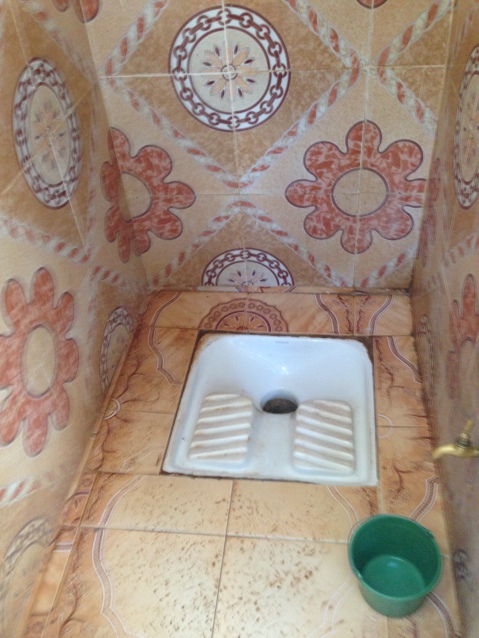
A quite clean “squat toilet” in the Moroccan countryside… Note the water spigot & little bucket? Yeah, that’s how you clean yourself and “flush” your waste!
There are a few other things to keep in mind as you traveling internationally and feel the “call of nature.”
- It always pays to carry some toilet paper with you as you travel… even if you find a toilet that has a TP dispenser, it could be empty. In more rural areas &/or less developed countries, toilet paper may clog the plumbing. Often, in such areas, there will be signs telling you how to dispose of used TP. If there is no sign, there will be a small wastebasket in the “stall” with dirty paper that will be your clue… it’s not gross, it’s just the way things are done.
- In other locations, like what we experienced in many Moroccan towns and wayside stops, there will be a water tap and a small bucket that you use to clean yourself (that’s why the left-hand is considered “unclean”!) and to flush your waste.
- Carry small change with you because you may have to pay to use the toilets. In some European cities, public toilets are ofter pay toilets. In other locations, such as Morocco, an attendant sits near the entry-way to the toilet facilities… sometimes dispensing toilet paper as well. Even if the attendant does not insist on you paying when you enter, it is polite to leave a small tip when you exit.
Self Reflection Post
Story & Photos by Sammie Keller, Washington State
Going to Morocco was honestly the first true thing I have ever done “by myself,” so to speak. I have gone traveling before, but it was always walking along side my parents. So to go to a country where I knew nothing about the culture, the way of life, the setting (other then the wildlife knowledge I had, which did little to help me) or having someone I felt like I could fall back on was stressful. But after looking back on the trip, I realized I learned more by having that experience instead of being surrounded by the parents and merely sight seeing, I was able to take in the culture, the society, and the people in an educational setting that was set at a relaxed pace.
To take this two week experience and condense it into just a mere self reflection is a significant challenge for me. It is hard to explain all of the things I saw at the markets and how the social interactions varied upon whom you were bartering with, or how beautiful the architecture was with their calligraphic designs and geometric tiling, or even just the simplistic beauty that was the forests, the farm lands, and even the deserts. In my eyes, everything was an experience. Everything was something to be explored and questioned, and everyone I was able to communicate with was an opportunity to learn more.
In the end, I walked off the plane in Morocco with some questions I wished to have answered. When I stepped off the plane in New York I had gained those answers but had countless more. I was just expecting to focus on the wildlife of the Moroccan region, but instead I got so much more. The people, the culture, their religion, everything! To get the opportunity to experience a new way of life, a new culture, and just a new outlook on what some people’s lifestyle looks like outside the United States is amazing, and you can guarantee this is a trip, as well as an opportunity, I will never forget.
Self Reflection Post
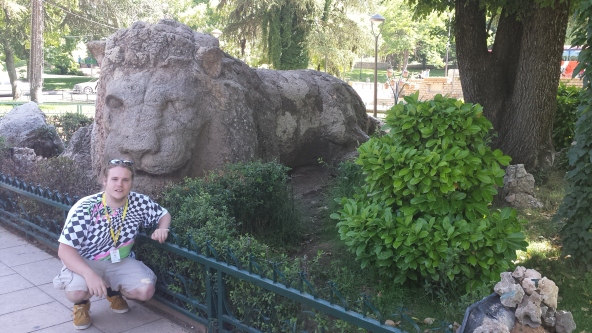
Adam at the Stone Lion in Ifrane, Morocco
Story by Adam Crittenden, Washington State
This trip to Morocco with ARAMFO was my first time being out of the country. I was very hesitant and nervous before departing, but now I am extremely excited to keep traveling and learning about different cultures and people. I saw a ton, learned a ton, and most importantly had a ton of fun. This was definitely the most amazing experience of my life thus far and while there were some bumps in the road, as to be expected, overall I think the trip was phenomenal.
I loved the fact that each city was unique in its own way, and each new destination was different than the last. I think that some of my favorite parts of the trip happened while we were staying in the city of Marrakech. This is because, we got to explore the large souk on our own and have time to go shopping and barter with the multitude of shop owners. Additionally, in the souk was when I had my first encounter with monkeys during the trip. I say it was my first encounter because when we visited the waterfall near the end of the trip I had a mother and her baby climb on my head as well. Also while in the souk we had the chance to interact with locals and use some of the French and Darija that we learned prior to visiting the country. Aside from the souk, I also had the opportunity to ride a camel while we were in Marrakech.
One of the best elements of the trip was the fact that we had guides with us on the buses wherever we were going. This made the long trips much more enjoyable than just sleeping or looking out the window for 5 hours. I think that the guides were full of interesting and valuable information and I was trying to absorb and record as much as I could over the bus rides. I think that this experience is going to be beneficial to me in my professional and personal life because I learned a lot about people, communication and also myself while on this trip. I learned to be more open-minded, patient, understanding, confident, and adaptable. I feel like studying abroad was the best decision I have made and I highly encourage everyone to travel as much as possible and learn about other cultures whenever they can. In conclusion, I think the most important thing I learned was that; the best way to bridge the gap and end cultural misrepresentations is to communicate and listen. When it comes down to it, we are all just people who want to live peacefully and be happy.
“No… No…”
Story & Photos by: Kara Hackler, Issaquah, Washington
Throughout our time in Morocco we had a lot of interesting encounters with the people and landscape of Morocco. One moment that I will probably never forget is when we stopped at a rest stop between Ouarzazate and Marrakech where we went into an Argan Oil shop. Some of the nuts used to produce argan oil are also used to made dips and spreads for bread. I am some what of a picky eater, and I was feeling a little car sick, so I tried to avoid being handed a piece of bread, but eventually the woman showing us around got to me and handed me one. I did not want to be rude so I ate as much of the bread as I could and threw away the rest. Next to the garbage was a man who watched me do this. He looked up from the garbage can, looked at me and said very sternly, “No… No…” He then picked up my bread and put it back on the table. I later found out that my friend happened to eat that piece of bread because she did enjoy the dips and spreads.
This has been a really great anecdote to tell friends and family back home, but I also think that it sums up a lot of my experiences in Morocco.
During our stay in Morocco, I think I heard the word no more times than I have ever said it in my life. This story was only one of the first times I heard no throughout my entire trip. Many times with haggling with some of the street vendors the only word they knew was no. We would hold up numbers with our fingers or write down numbers, and if a vendor did not like the number they would shake their head and say no. Additionally, others would tell us no when we were doing something wrong; wearing something the wrong way, going somewhere we were not supposed to be going, etc. Honestly, I think this says a lot about how vocal they are about their standards. Here in America, I know that I could walk out of my house wearing jean shorts and a tank top and I probably would not get a lot of attention. However, in Morocco there were a few fellow travelers who did wear that and they got quite a few more head turns and attention then the rest of us Americans. Moroccans have cultural norms just like any other culture. But their norms were much different than the ones I have grown accustom to in America. This was one thing that I thought I understand pretty well pre-departure, but did not realize just how different it is and how big of an impact that had on me. I cannot say that what I know and love is best, but that is what I am used to. Being in Morocco for just two weeks experiencing this change was a little hard, especially at the end when a lot of us were getting homesick.
One of those things I was used to, was refusing or not finishing foods or drinks when I did not want to eat or drink them. I realize that I should have tried to spreads because that is what is customary in Morocco. Being told no by this total stranger (who I am pretty sure did not even work at this shop) because I did not want to finish the bread, when I did not even want it in the first place, was actually kind of hard to deal with. At first I was embarrassed, because I am in their country and I should follow their cultural standards. But then the next day I was angry that this guy had tried to make me feel bad for something that was forced on me. And from there it was a tumbling cycle of embarrassment and anger about the whole thing. I have all these reasons to justify throwing it out: I didn’t want it in the first place, I was feeling sick, I’m a picky eater and don’t want to offend them by not liking their food, etc. But ultimately I come back to the resolution that maybe I should have tried hard to get rid of the bread some other. Maybe just give it to the friend so she wouldn’t have to eat garbage bread, or even just put it back in the basket.
However, I think I have now reached a point where I can laugh about the whole thing, while still feeling like I learned something from my mistake. Making mistakes in a different country is a lot harder than making a mistake at home. At home there is still the safety net of “Well I know that I did not do anything that bad” or just feeling safe in your own home and country to make mistakes and learn from them. But I think in the two weeks I was in Morocco, and the mistakes I made there, I have learned just as much from those as I have from the mistakes I have made at home. But that is what was great about this trip and any other international trip I will take in the future: I am a different person now that I am back. I now see a lot of the things that happen in America that would not fly in Morocco. I now see the Arabic language as something I can partially decipher and teeny tiny bit. Moroccan Argan Oil has lost a little bit of it’s pizzaz. And now I will now always finish bread that is offered to me.
Self Reflection Post-Morocco
Story & photo by Kory Caldwell
My experiences in Morocco ranged from exciting to far beyond my comfort zone in a host of environments I’d have never thought I’d find myself in. The vastly varying cities, people and lifestyles were amazing to witness and without a doubt expanded my minimal concept of North Africa into many memories. The students I met with and the students I traveled with were wonderful to get to know and had a lasting impression on me.
It’s difficult to summarize my pre-departure expectations as they relate to my experiences (and newly acquired knowledge) now that I’m back, post-Morocco. I didn’t have much in the way of social, cultural, or environmental expectations going into Morocco (besides temperature), but I think this revealed to me that I had a different kind of preliminary mental framework and one big expectation. Having little to no knowledge of Morocco, outside of a vague geographic location, lead to me to think I would be more receptive to the wealth of new cultural information I’d be collecting visually through all of the places and people I’d soon become acquainted with. This wasn’t as accurate as I’d hoped, not because I wasn’t receptive, but because real social and cultural information is far below the surface. I learned so much from the seminar we attended and from conversations with the professors of UHII. Almost all of my questions regarding middle east media representation, the Muslim Brotherhoods reception by average citizens, the complicated Moroccan language situation, and other relevant topics were answered extensively. Despite this, with every explanation I more I felt I needed to know more and more to really grasp what was going on. The more knowledge I gained the more holes in it I became aware of. I think my biggest and most clear realization is that when encountering another culture you learn far less about it than you learn how much you don’t or can’t know. I expected to come home with a lot of knowledge, but I came home with a lot of questions. Perhaps these are even better in a certain sense.
I definitely caught multiple travel bugs. However, the one that doesn’t call for meds will probably last with me a lot longer. I’m going to be looking forward to that combination of confusion and interest walking around city like nothing in my home country until I’m able to replicate that experience again. Before I went to Morocco I thought travel could be an isolated experience, but the surprises certainly stay with you. I didn’t think I’d be walking around downtown LA and having my mind jump back to alleyways in Fez or the beach in Casablanca. When I was Morocco my observations felt intentional. I had written pages and pages in my journal about everything I saw. How graffiti had consistent differences depending on its language, how Arabic graphic design lacked pictographic logos, and how mosque-related building constraints affected infrastructure all covered the pages of the book. However, I think these things really became real to me after coming back and not noticing them anywhere after two weeks of writing about them.
I know I can say any number of topical tidbits and informational anecdotes to represent my short but involving Moroccan, cultural education, but I also know I only scratched the surface. I learned that the world is far too dynamic to really grasp at the core of any country in two weeks. However, after you get out there into the world, you want to do so more than anything. At this point I’m very happy to be home, but I’m looking forward to the next time I’m heading out.
Staying Hydrated in Morocco
Story by: Kory Caldwell, Fes, Morocco
Photo by: Lyla Ye
When traveling in Morocco it was not uncommon for the American students to be drinking a few liters of bottled water when they could get their hands on it. The Moroccan climate, much closer to the equator and much hotter than our usual temperate highs and lows in the US made hydration an important part of travel for us. Water access, sanitation, distribution and treatment in Morocco is differs from US H20 in a number of key factors. The CDC urges travelers to be diligent and to avoid drinking any water (Determination of Fluoride in Tap Water in Morocco Using A Direct Electrochemical Method) outside of sealed containers and even ice to avoid contracting a bacterial infection such as Typhoid. This might be good advice for those who can afford it, but what about the rest of Morocco? Bottled water may not be a solution for isolated communities in need of clean accessible hydration, but many are looking for new solutions. The International Atomic Energy Agency has recently helped give Moroccan hydrologists a new technique (New Sources of Water in Morocco) for finding water. Isotopic Hydrology, a new tool for Morocco, will help experts like Nabil Mosleh of ONEE (a bulk water provider) track the history of water sources and find solutions to isolated places like Guelmin, a town looking for better ways to get water to its residents. The IAEA says that now that Morocco’s researchers have this new tool it will serve as the focal point for more hydrological solutions in northern Africa. Another new development is the addition of organic and ceramic membrane filter technology from the European Space Agency now in use in Morocco (Space Brings Fresh Water to Morocco).
In Sidi Tabi, near Rabat, ground water is available but unfortunately very unfit for drinking. Thanks to a new water treatment facility built there, however, clean water is now being created and used for over 1200 students. Now that it has shown to be successful, there is speculation of more membrane treatment plants to be built. Morocco is looking to fix its water dilemmas on a national scale as well. In 2007 Morocco took out a hundred-million dollar loan for water development and sanitation (Results Profile: Morocco Water & Sanitation) and instigatted a 34 billion MAD program called the National Irrigation Water Efficiency Program. Just like we became aware of water difficulties during our visit, the Moroccan government is also aware and looking to adjust. Morocco is currently on its way to being on track for its Millennium Development goals as it continues to increase spending on programs to fix its hydrological puzzle.
Spanish or Moroccan, that is the question
Story & Photo by: Lyla Ye, Tangier, Morocco
During our visit in Tangier, we visited the Mediterranean coast where we could see Spain right across the strait of Gibraltar. As you can see from the photo above, Spain is visible from Morocco with the naked eye. Spain is just a 40-minute boat ride away if you take the fastest ferry. As we all know, Morocco had been colonized for a long period of time. In 1912, the Treaty of Fez made Morocco a French protectorate. Spain also gained authority over Ifni (in the south) and Tétouan (in the north). Tangier was made an international zone in 1923 under the joint administration of France, Spain, and Britain under an international convention signed in Paris on December 18. It wasn’t until 1956 that Tangier finally joined with the rest of Morocco and gained full sovereignty. There are still two more Spanish enclaves that are within Morocco’s boarders: Ceuta and Melilla.
According to our tour guide, Mr. Aziz Mikdar, Moroccan citizens need to get a visa when traveling to Ceuta and Melilla, even though the two cities are right within the Moroccan land. Spain still refuses to turn over the two cities even today. As a result, the official language in these cities is Spanish, although a large portion of the population consists of native Moroccans who speak Arabic and Berber. However, the United Nations list of Non-Self-Governing Territories does not consider these Spanish territories to be colonies. It is very likely that Ceuta and Melilla will remain under Spanish control, at least for the foreseeable future. Our tour guide expressed strong dissatisfaction toward the Spanish government and wished that one day Ceuta and Melilla would be “de-colonized” and return to their motherland. The Kingdom of Morocco has gone through much to gain its independence. Spain uses this as an excuse to maintain control of the two cities —— Spain claimed the territories before Morocco got independence from France, but what about the history before that?
Fez Medina
Fez Medina — Leather Tannery
Story by: Adam Crittenden, Fes, Morocco
Photo by: Jordan Vidmore
In Moroccan cities there are mostly areas of new developments, although there are also sections known as the medina– or “old city”. The medinas are representative of the old way of life that the culture has endured for hundreds, if not thousands, of years. Each medina is unique in it’s own way, however, they all share common characteristics across the country no matter what city you may end up in. With tall clay walls composed of alleyways, hole-in-the-wall shops, and vendors every few steps; the medina exemplifies generations of culture and history around every corner.
On our visit to the medina in the city of Fez, we had the opportunity to take a walk back in time. According to our guide, the medina in Fez is the oldest of all the medinas in the country and in recent years was declared a UNESCO World Heritage site, and there have been restoration projects aimed at protecting this phenomenal piece of Moroccan history and culture. We additionally visited a museum just outside the medina that housed artifacts of Moroccan culture from wood and iron working tools, to musical instruments, to ancient weapons and even some early writings from the holy Quran on stone plaques.
Inside of the medina it was very much like the souk in the medina of Marrakech–just much smaller. Harboring clothes, trinkets, tea sets, spices, sweets, fish and raw meat as far as the eye could see. One unique characteristic of the Fez medina is the leather tannery (pictured above) where the local people still tan the leather strips in small circular pools–the same way it has been done going back many generations. It was amazing to see how even with growing technological advances and modernization happening on a global scale; the Moroccan people still stick to their roots and follow the traditional practices of many agricultural and craftsmanship industries. As the old saying goes, “if it ain’t broken, then why fix it?”
Morocco Royalty
Story by: Kara Hackler, Fes, Morocco
Photo by: Sammie Keller
When we think of a king or queen, many Americans will probably think of the United Kingdom. However, Morocco is also a constitutional monarchy. This essentially means that while there is a constitution and democracy, there is also a king. In Morocco, much like the U.K., the royalty is truly respected by the people of Morocco. For a period of time though the King of Morocco had much greater power than the Queen of England, including being able to overturn laws and was the leader of the Moroccan army. However, when constitutional reforms came in 2011 the powers of the king minimized and the powers of the prime minister grew. The king now holds mainly honorific powers, including being titled as a “Commander of the Faithful” as a direct descendent of Mohammed.
The current king of Morocco is Mohammed VI, son of the late King Hassan II. King Hassan II is still a greatly beloved king even with his passing 1999. There are many landmarks named after him including streets, his face on money, a university, and the biggest mosque in all of Africa.
While Hassan II is a deeply beloved king, so is his son Mohammed VI, named after his grandfather who was the previous king before Hassan II. Throughout all the towns and cities we have visited in Morocco almost every single shop, hotel, or building, has had at least one picture of King Mohammed VI. At our hotel in Fes, we have seen the largest portrait of him in the lobby with a small Moroccan flag next to it. But even in the Medina, shopkeepers make some space for a picture of King Mohammed VI, pictured at the beginning. The King’s reach extends far beyond the major cities of Morocco, and all the way out to the country.
Morocco’s love of their King could make the biggest Obama fan seem minimal.
Monkey Business in Marrakech
Story by: Adam Crittenden, Marrakech, Morocco
Photo by: Jordan Vidmore
On an exploratory and intriguing trip to the market place, or Souk, in Marrakech, we had some interesting intercultural interactions that will stay with us long after the trip is over. For instance, the souk is located in a very large square with alley ways and merchant shops/stands that one could spend hours in discovering antiques, tea sets, hookahs, trinkets, authentic Moroccan dress, etc. The souk culture is based on a bargaining system between the shop owner and customer and there was typically four or five negotiations (in our case) before striking a deal–he may even pour you a cup of mint tea during the bargaining process to “soften you up.” In addition to the shops and stands where we were constantly being called to visit as we were passing by, there were food stands and juice vendors as well as animal tamers who pose their animals with people–typically tourists and typically for a price.
It is comparable to the Las Vegas strip where people often dress up like celebrities or cartoon characters and pose for pictures with travelers in return for tips. In Morocco however, it is common for some of the picture attractions to be exotic animals. In most cases if you tell them “la shoukran” or “no thank you,” they will not pursue you after initially approaching you. However, as you can tell from the above photo, I was not so lucky. As we were on our way out of the souk, I was approached by two monkey handlers and repeatedly said la shoukran (as I had spent all my dirhams I had brought for shopping), they were persistent and would not take “la” for an answer. Before I could blink; I had one monkey on my head and one on my shoulder. Afterward the men were demanding that I pay them for their primate “ambush” even though I was out of money. My group ended up having to bail me out of monkey prison for a price of 20 dirhams (about $2.40). While this was an interesting experience I will not soon forget, my advice for the souk is to: 1) keep walking, 2) avoid long eye-contact with vendors, and 3) remember la shoukran… Otherwise you may end up with a real monkey on your back–or two!
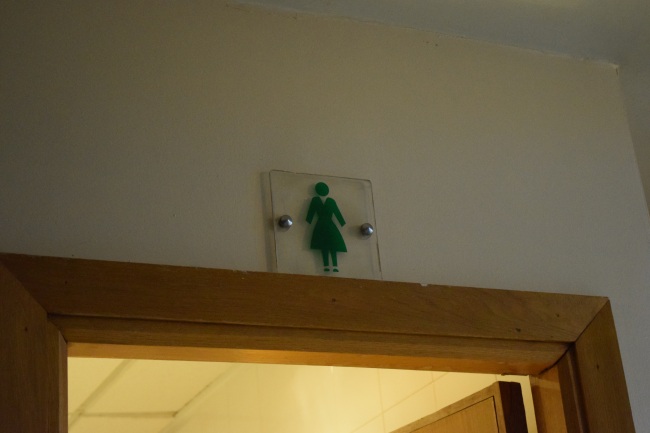



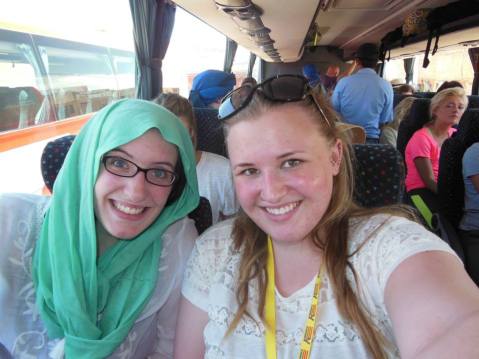


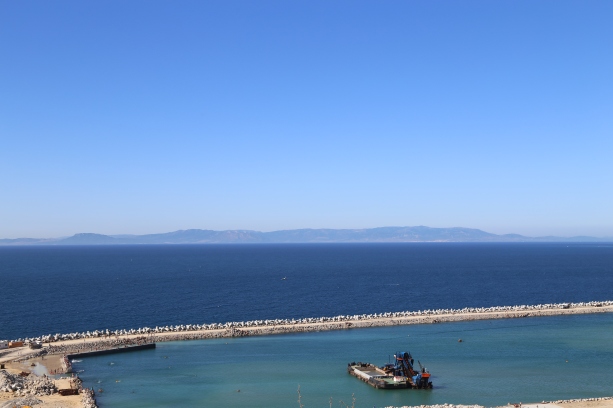
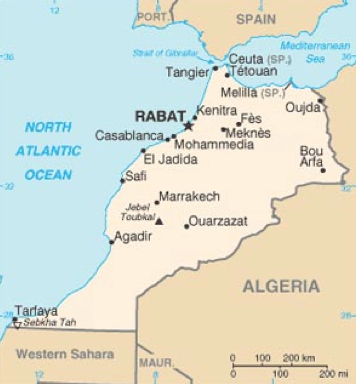
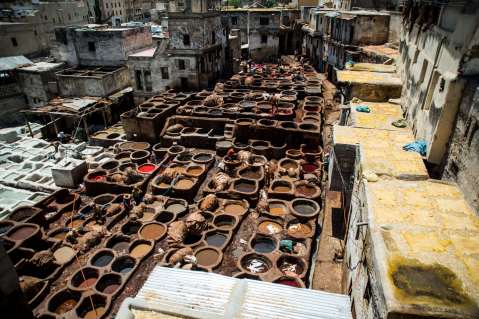
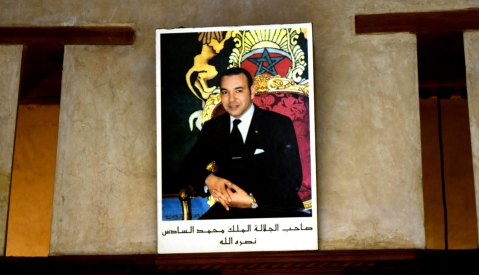

Recent Comments